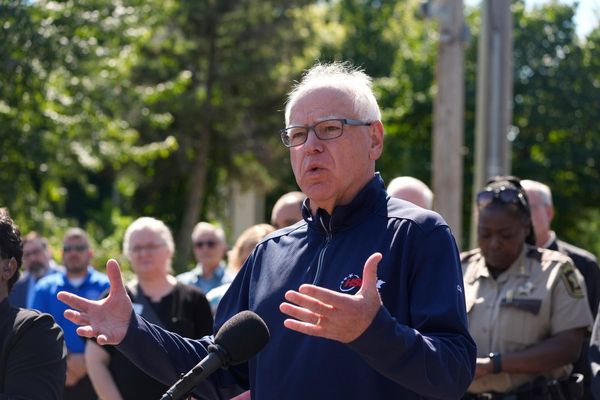
“Under the Trump administration, we will defend the proud tradition of female athletes, and we will not allow men to beat up, injure, and cheat our women and our girls.”
– Donald Trump during the signing of his Keeping Men Out of Women’s Sports executive order, 5 February 2025
“Our girls”. The line lands like parody. Grotesque and striking. A president whose policies have regularly harmed women, positioning himself as guardian of “our girls”.
That’s the absurd theater of American politics in 2025: women’s sports as shield and sword in a fight that has little to do with athletics. What’s become clear is that the Maga movement doesn’t love women’s sports; it loves them as a proxy. It’s a stage where old fears about gender and power can be reenacted, shorthand in a culture war that has nothing to do with the quality of the hoops being played.
And the WNBA – whose finals start on Friday as the Las Vegas Aces face the Phoenix Mercury – keeps getting dragged into the trenches. Players are sick of it. A’ja Wilson said it bluntly: “People love to use us as an example, as a punchline, but they don’t actually watch us play.” Debates over trans athletes, Caitlin Clark getting fouled or “protecting” women’s sports rarely include the voices of the women actually playing.
When those voices are ignored, the vacuum fills with nonsense. And rather than protecting women’s sports – or even helping by increasing funding in high schools or social teams – much of the right seems to want to rip it down. Take, for example, rightwing voices such as Clay Travis and Tomi Lahren, who have both backed the Keeping Men Out of Women’s Sports bill. They believe women should be protected in sports, yet laughed when sex toys were thrown on to courts during WNBA games this season. (The players did not find it amusing, nor presumably did the 12-year-old girl who was hit by one of the toys.)
Travis is particularly egregious. Despite his concern for female athletes, in 2023 he said he’d bet $1m that a good boys’ high school state champion would “absolutely smoke” the WNBA champs. There was no payout, only noise from a dying radio. That clip was circulated across conservative media and became a talking point, hardening into ideology. This type of discourse doesn’t protect or elevate female athletes, it diminishes them.
My regret is that I fell for the poison myself as a kid. My dad – not a cruel man, or some armchair critic (he played ball in New York playgrounds and more than held his own) – held the same views as Travis when it came to the abilities of WNBA players. He’d absorbed it, the way so many men did, and passed it down to me without thinking. This happens everywhere: on message boards as far back as 2009, when 25,000 anonymous avatars on TexAgs bickered into the void on the subject. My sadness is that my pops diminished the women’s game and didn’t even realize he was repeating someone else’s sneer. The sadness is increased by knowing that the strongest person I knew – physically and mentally – was my mom.
Why not just celebrate what it takes to play at the pro level? Judging the women’s game as “less than” simply because it doesn’t look like the NBA or men’s college ball misses the point entirely. The measure should be the quality of execution, the intelligence of the playmaking, the creative ways women bend the game around their skills. When you separate it from those comparisons, you see the WNBA for what it is: elite hoops, defined by its own standards.
Besides, the older I got, the more ball I watched, the absurdity became clear: 90% of high school players are awkward, maladroit, and done with organized basketball after graduation. The WNBA, meanwhile, demands refinement: passing, shooting, dribbling at an elite level. Obviously, men are naturally bigger and stronger on average. But the gap between grown women who play professionally and a teenage team with maybe two decent players isn’t what detractors pretend it is. The difference? A lifetime of work and players that don’t rely solely on strength and height (although there is plenty of that in the WNBA too).
While conservatives are stuck rehashing the same tired hypotheticals, the women’s game has been evolving right in front of them. A decade ago, WNBA teams averaged around 15 three-pointers a game; today, many launch closer to 25–30, with efficiency climbing alongside. The three-point revolution has transformed how the league is played, bridging gaps between male and female playing styles and showcasing the league’s malleability.
That’s what always struck me about the “protect women’s sports” crowd: they don’t actually watch the games. Gallup found 90% of Republicans (and 40% of Democrats) say trans athletes should only play on teams that match their birth sex. Yet S&P Global reports a stranger truth: only 18% of adults follow women’s sports, period. Men make up the majority of WNBA viewership, but the ones watching aren’t the ones using it for political dunking. If they were, they wouldn’t denigrate these women like they are.
The hypocrisy is astounding, especially by those who constantly call to keep sports separate by gender. As Ebony Dumas, a former Division I college baller, and one of the most incisive voices on WNBA X, told me: “The W has always been rooted in fundamentals and old-school basketball principles – that’s what separates it from the NBA. They don’t rely solely on athleticism. The midrange is still a key part of the game, and the intensity on both ends is non-negotiable.”
And people are watching. WNBA viewership hit a record high this season. The 2024 NCAA women’s final outdrew the men’s. Merchandise flew, and screens lit up, proof that the interest isn’t just on TV but in how fans show up for the game. And still, the critics said no one watched. And still, the critics said no one cared.
The disconnect between the league’s tangible growth and how it’s still talked about runs deep. Instead of celebrating increased competition, the yapping too often reduces women’s basketball to lazy hypotheticals. Or dismal comments about race and sexuality. The charade obscures reality: the WNBA is expanding to the Bay Area and Toronto and striking richer media deals.
That’s the backdrop for Trump’s line about “protecting our girls.” It isn’t protection – it’s projection. He isn’t defending the WNBA athletes selling out arenas. He’s defending a chimera, a stage where women’s sports are props in a never-ending grievance play.
Meanwhile, the league burns on. The ball is moving, the threes are falling, the athletes are evolving in ways no hypothetical could capture. And the more politicians and pundits posture about “our girls,” the more obvious the gap becomes between their culture-war theater and the women actually out there hooping.
There is no “our girls” and “your girls”. There’s just game.







